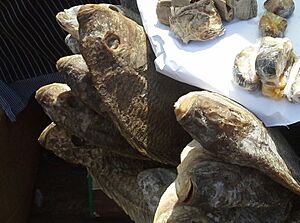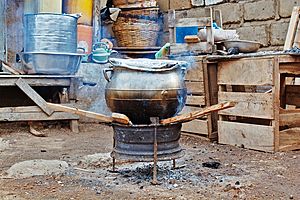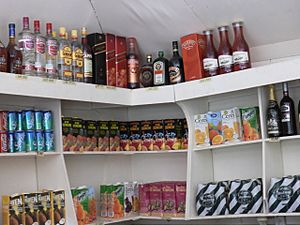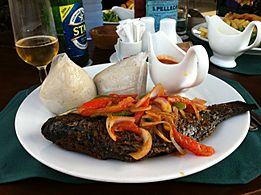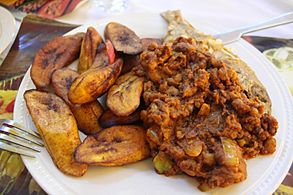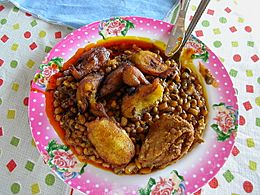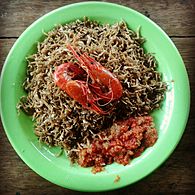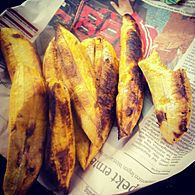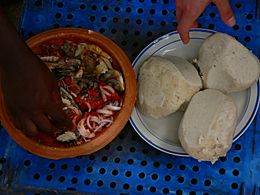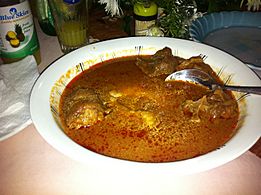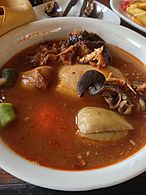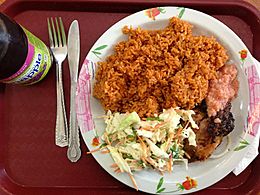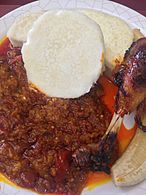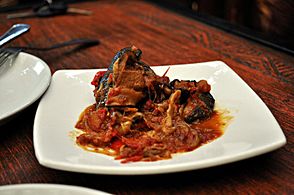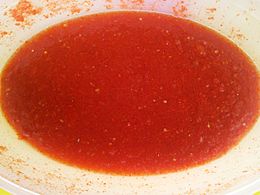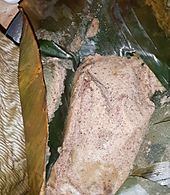Ghanaian cuisine facts for kids

Ghanaian cuisine is the delicious food of the people of Ghana. Most Ghanaian meals are built around a starchy main food. This staple food is usually eaten with a tasty sauce or soup that also has a protein like meat or fish. Many Ghanaian soups and stews get their red or orange color from common ingredients like tomatoes, hot peppers, and onions.
Contents
Main Staple Foods in Ghana

Different parts of Ghana use different main foods. In the southern part, common staples include cassava and plantain. Up north, people often eat millet and sorghum.
Foods like yam, maize (corn), and beans are popular all over Ghana. Sweet potatoes and cocoyam are also important parts of the Ghanaian diet. Today, foods like rice and wheat are also becoming more common in Ghanaian cooking.
Here are some Ghanaian dishes made from these staple foods:
Dishes Made with Maize
- Akple is a traditional meal from the Ewe people. It is made from corn flour and can be eaten with spicy pepper sauces, stews, or soups. It often comes with okra soup or herring stew.
- Banku was created by the Ga Dangme tribe. It is made from fermented corn dough, often mixed with cassava dough. Unlike Ga kenkey, it does not use corn husks.
- Mmore is a cooked fermented corn dough, similar to banku, but without cassava. It is popular among the Akan people.
- Kenkey/komi/dokonu is fermented corn dough. The Ga call it komi or Ga kenkey. Another type, Fante dokono or Fanti kenkey, is wrapped in plantain leaves. This gives it a different texture, flavor, and color. Both are boiled until they become solid balls.
- Tuo zaafi is a dish from Northern Ghana made with millet, sorghum, or maize.
- Fonfom is a maize dish that is popular in southwestern Ghana.
Dishes Made with Rice
- Waakye is a dish of rice and beans with a purple-brown color. This color comes from a special local grass called Sorghum bicolor. The rice is cooked with this leaf, coconut, and beans like black-eyed peas or kidney beans.
- Omo Tuo (Rice ball) is sticky mashed rice. It is usually eaten with groundnut soup.
- Plain rice is simply boiled rice. It is often served with many types of red stews.
- Jollof rice is rice cooked in a stew with stock, tomatoes, spices, and meat. This dish came from Djolof traders from Senegal. In Ghana, it is often eaten with stewed, roasted, or grilled goat, lamb, chicken, or beef.
- Fried rice is a Ghanaian version of Chinese-style fried rice.
- Angwa moo is also called "oiled rice." To make it, onions are fried in oil, then water is added, and finally the rice is cooked in this mixture. This gives the rice an oily feel and a special smell. It can be made with vegetables or minced meat and is often served with ground pepper, sardines, or fried eggs.
- Ngwo moo (palm rice) is like oiled rice but made with palm oil. The type of palm oil used changes the taste.
Dishes Made with Cassava
- Kokonte or abete is made from dried cassava powder. It is usually served with groundnut soup, which can have different meats like tripe, lamb, or smoked fish.
- Fufu is a soft dough made by pounding cassava and plantain, or yam and plantain, or cocoyam. This dish is always eaten with one of Ghana's many soups.
- Gari is made from cassava. It is often served with Red red, a stew of fish and black-eyed peas, or with shito (a spicy sauce) and fish.
- Attiéké or Akyeke is made from cassava. It is popular among the Ahanta, Nzema, and Akan-speaking people in Ivory Coast.
- Plakali is also made from cassava and is popular in the same regions as Attiéké.
Dishes Made with Beans
Some dishes do not follow the starch and stew rule. These include Red red and tubaani, which are mostly made from beans. Red red is a popular Ghanaian bean and fish stew. It is served with fried ripe plantain and often with gari and fish. It gets its name from the palm oil that colors the bean stew and the bright orange of the fried plantain. Tubaani is a boiled bean cake, similar to moin moin in Nigeria.
Dishes Made with Yam
- Ampesie is boiled yam. It can also be made with plantain, cocoyam, potatoes, or cassava. This dish is traditionally eaten with fish stew, which has tomatoes, oil, and spices.
- Yam fufu is fufu made with yam instead of cassava, plantain, or cocoyam. This soft dough is traditionally eaten with Ghanaian soup. It is popular in Northern and southeastern Ghana.
- Mpotompoto (yam casserole or porridge) is made by cooking slices of yam with water, pepper, onions, tomatoes, salt, and seasonings.
Soups and Stews in Ghana
Most Ghanaian main dishes are served with a stew, soup, or mako. Mako is a spicy sauce made from raw red and green chilies, onions, and tomatoes. Ghanaian stews and soups are very flavorful, using many different ingredients, spices, and textures.
Vegetables like palm nuts, peanuts, cocoyam leaves, ayoyo, spinach, wild mushrooms, okra, garden eggs (eggplant), tomatoes, and various types of beans are key ingredients. Sometimes, beans can even be the main protein.
Common proteins in Ghanaian soups and stews include beef, pork, goat, lamb, chicken, smoked turkey, tripe, dried snails, and fried fish. Sometimes, different types of meat and fish are mixed in one soup. Soups are usually served as the main part of a meal, not as a starter.
It is also common to find smoked meat, fish, and seafood in Ghanaian soups and stews. These can include crab, shrimp, periwinkles, octopus, snails, grubs, duck, offal, and pig's trotters. Oysters are also used.
Meat, mushrooms, and seafood can be smoked, salted, or dried. This adds flavor and helps keep them fresh. Salted fish is often used to flavor fish stews. Spices like thyme, garlic, onions, ginger, peppers, curry, basil, nutmeg, sumbala, prekese, and bay leaf are carefully used to create the unique and spicy flavors of Ghanaian food.
Palm oil, coconut oil, shea butter, palm kernel oil, and peanut oil are important Ghanaian cooking oils. For some dishes, these oils cannot be replaced. For example, palm oil is essential for okro stew, eto, fante fante, red red, Gabeans, egusi stew, and mpihu/mpotompoto. Coconut oil, palm kernel oil, and shea butter are less popular for cooking now. This is because of new refined oils and old media messages against them. They are mostly used in some traditional homes, for making soap, or by street food sellers as a cheaper option.
Popular Ghanaian soups include groundnut soup, light (tomato) soup, kontomire (taro leaves) soup, palm nut soup, ayoyo soup, and okra soup.
Ghanaian tomato stew or gravy is often served with rice or waakye. Other vegetable stews are made with kontomire, garden eggs, egusi (pumpkin seeds), spinach, and okra.
Breakfast in Ghana
In modern Ghana, most of the dishes mentioned earlier are eaten for lunch and supper. However, people who do manual labor and many city dwellers still eat these foods for breakfast. They often buy them from street vendors.
Another popular breakfast is huasa koko, a sweet porridge from Northern Ghana. It is often eaten with koose or bread and groundnut.
In big Ghanaian cities, working people often have fruit, tea, chocolate drinks, oats, rice porridge (called "rice water"), or kooko (fermented maize porridge). They might also have koose/akara or maasa (fritters made from beans, ripe plantain, and maize meal). Other breakfast foods include grits, tombrown (roasted maize porridge), and millet porridge.
Bread is also a big part of Ghanaian breakfast. Ghanaian bread is known for being good quality. It is baked with wheat flour, and sometimes cassava flour is added to make it even better. There are four main types of bread in Ghana: tea bread (like a baguette), sugar bread (a sweet bread), brown (whole wheat) bread, and butter bread. Rye bread, oat bread, and malt bread are also common.
Sweet Foods in Ghana
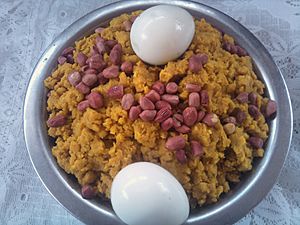
Ghana has many traditional sweet foods. Some are not as common today because they take a long time to prepare. Ghanaian sweet foods can be fried, barbecued, boiled, roasted, baked, or steamed.
Fried sweet foods include spiced ripe plantain cubes called kelewele, sometimes served with peanuts. Koose is made from peeled beans, while acarajé or akara is made from unpeeled beans. Other fried sweets are maasa, pinkaaso, and bofrot/Puff-puff (made from wheat flour). Waakye dzowey and nkate cake are made from peanuts. Kaklo and tatale are ripe plantain fritters. Kube cake and kube toffee are made from coconut. Bankye krakro, gari biscuit, and krakye ayuosu are made from cassava. Condensed milk toffee, plantain chips (or fried plantain), and wagashi (fried farmer's cheese) are also popular fried Ghanaian treats.
Kebabs are popular barbecued foods. They can be made from beef, goat, pork, soy flour, sausages, and guinea fowl. Other roasted savory foods include roasted plantain, maize, yam, and cocoyam.
Steamed fresh maize, yakeyake, kafa, akyeke, tubani, moimoi (bean cake), emo dokonu (rice cake), and esikyire dokonu (sweetened kenkey) are all examples of steamed and boiled foods. Sweet bread, plantain cake, and meat pies (like Jamaican patties and empanadas) are baked savory foods. Aprapransa, eto (mashed yam), and atadwe milk (tiger nut juice) are other savory foods. Gari soakings, a mix of gari (dried, roasted cassava), sugar, groundnut (peanut), and milk, is a modern favorite.
Ghanaian Drinks
In southern Ghana, drinks like asaana (made from fermented maize) are common. Near Lake Volta and in southern Ghana, you can find palm wine, which comes from the palm tree. This wine ferments quickly and is then used to make akpeteshie, a local strong alcohol. Akpeteshie can also be made from molasses. Also, a drink called ice kenkey is made from kenkey and chilled.
In northern Ghana, bisaab/sorrel, toose, and lamujee (a spicy sweet drink) are common non-alcoholic drinks. Pitoo (a local beer made from fermented millet) is an alcoholic drink.
In Ghana's cities, you can find fruit juice, cocoa drinks, fresh coconut water, yogurt, ice cream, carbonated drinks, malt drinks, and soy milk. Ghanaian companies also make alcoholic drinks from cocoa, malt, sugar cane, local herbs, and tree barks. These include bitters, liqueurs, dry gins, beer, and aperitifs.
Street Foods in Ghana
Street food is very popular in both rural and urban areas of Ghana. Many Ghanaian families buy food from street vendors several times a week. You can find all kinds of foods, including main dishes like kenkey, red red, and waakye. Other tasty foods sold by street vendors include raw steak, boiled corn on the cob, boflot, and roasted plantain.
Ice kenkey is a popular chilled dessert sold by street vendors in open-air markets.
Common Ghanaian Dishes
-
Red-red: bean and fish stew with fried plantain
-
"One Man Thousand": cooked shrimp and fried Tanganyika sardine
-
Fried yam with spicy chicken and kpakpo shito (ground green peppers)
-
Jollof rice with coleslaw and barbecue chicken
-
Cooked yam and plantain, with "garden egg" (aubergine) stew and chicken
-
Waakye (rice and beans) served with spaghetti and boiled egg
-
Ground red pepper, a Ghanaian special, often eaten with banku and kenkey
See also
 In Spanish: Gastronomía de Ghana para niños
In Spanish: Gastronomía de Ghana para niños




